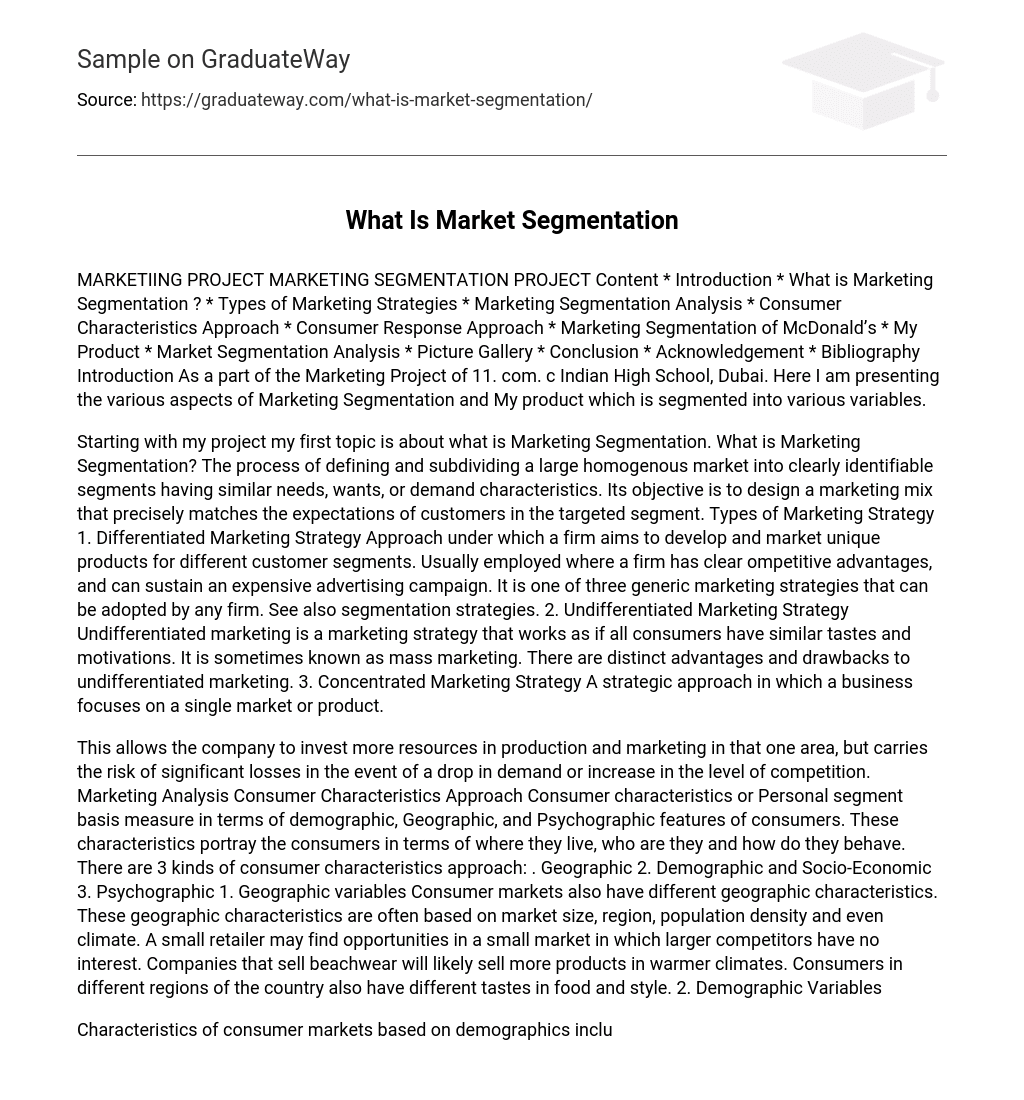Here I am presenting the various aspects of Marketing Segmentation and My product which is segmented into various variables. Starting with my project my first topic is about what is Marketing Segmentation.
The process of defining and subdividing a large homogenous market into clearly identifiable segments having similar needs, wants, or demand characteristics. Its objective is to design a marketing mix that precisely matches the expectations of customers in the targeted segment. Types of Marketing Strategy
- Differentiated Marketing Strategy Approach under which a firm aims to develop and market unique products for different customer segments. Usually employed where a firm has clear ompetitive advantages, and can sustain an expensive advertising campaign. It is one of three generic marketing strategies that can be adopted by any firm. See also segmentation strategies.
- Undifferentiated Marketing Strategy Undifferentiated marketing is a marketing strategy that works as if all consumers have similar tastes and motivations. It is sometimes known as mass marketing. There are distinct advantages and drawbacks to undifferentiated marketing.
- Concentrated Marketing Strategy A strategic approach in which a business focuses on a single market or product.
This allows the company to invest more resources in production and marketing in that one area, but carries the risk of significant losses in the event of a drop in demand or increase in the level of competition.
Approach Consumer characteristics or Personal segment basis measure in terms of demographic, Geographic, and Psychographic features of consumers. These characteristics portray the consumers in terms of where they live, who are they and how do they behave. There are 3 kinds of consumer characteristics approach:
- Geographic
- Demographic and Socio-Economic
- Psychographic
Geographic variables Consumer markets also have different geographic characteristics. These geographic characteristics are often based on market size, region, population density and even climate. A small retailer may find opportunities in a small market in which larger competitors have no interest. Companies that sell beachwear will likely sell more products in warmer climates. Consumers in different regions of the country also have different tastes in food and style.
Demographic Variables Characteristics of consumer markets based on demographics include differences in gender, age, ethnic background, income, occupation, education, household size, religion, generation, nationality and even social class. There are 7 types of Demographic Variable:
- Age
- Sex
- Education
- Income
- Religion
- Occupation
- Family Size
Psychographic Variable Consumer market characteristics can also be psychographic in nature. Psychographic characteristics of consumers include interests, activities, opinions, values and attitudes. Obviously, many magazines are geared toward a consumer’s interest.
For example, prenatal magazines target expectant mothers who are interested in learning more about caring for a baby. Additionally, consumer activities can include participation in martial arts or basket weaving. Opinions and attitudes can be both specific and general. A company may better understand consumer opinions and attitudes after conducting a focus group, and can use that information to tailor advertising or marketing campaigns. Consumer values can pertain to how a group of individuals feels about certain social issues, which can be of interest to non-profit or charitable organizations.
Consumer Responses Approach Unlike consumer characteristic approach, the consumer responses approach believes in why a consumer buys a product than asking us who is the customer. Customer responses are much more important which can be made as the basis for segmentation.
- Benefit Response
- Usage Response
- Loyalty Responses
- Occasion Response
From this project we can conclude that Segmentation is a necessity for all the companies and organisations in the market as it plays a very important role in the development and technological improvement. It also helps the satisfaction of the customers . Acknowledgement First of all I would like to thank my Marketing teacher Mrs Mary john and my school, The Indian High School for giving me this opportunity to carry out this project. I would also like to thank my parents for supporting me throughout this project. Last, I would like to thank all my friends for their encouragement and help.





